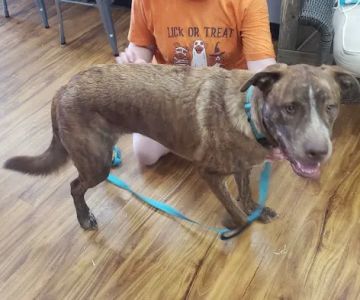How to Stop a Dog from Guarding Food
As a dog owner, I’ve learned that food guarding is a common behavior in many dogs. It can be concerning, especially if your dog starts to show aggression or anxiety when someone approaches their food. But the good news is, with patience and the right techniques, food guarding is a behavior that can be managed and reduced over time. In this article, I’ll share how I tackled this issue and offer practical tips to help you prevent your dog from guarding food.

1946 S Christopher Columbus Blvd, Philadelphia, PA 19148, USA
See Details1. Understanding Why Dogs Guard Their Food
Food guarding, also known as resource guarding, is a natural instinct in dogs. It’s a way for them to protect their food or any other valuable resource, especially when they feel threatened by potential competitors. It’s important to recognize that food guarding doesn’t always stem from aggression; it’s often due to anxiety or fear. In my experience, dogs that have been through traumatic or stressful situations are more prone to this behavior.
When a dog guards its food, it may show various signs such as growling, snapping, or even retreating to a safe corner to eat. Understanding these signs is key to knowing how to intervene effectively without escalating the situation.
2. Steps to Stop a Dog from Guarding Food
Here are the steps I took to reduce my dog’s food guarding behavior:
- Step 1: Don’t Punish the Behavior – The first thing I learned is that punishing a dog for food guarding can escalate anxiety and worsen the problem. Dogs may not understand the punishment and could associate eating with fear or stress. Instead, it's essential to approach the situation with patience and positivity.
- Step 2: Make the Food Area a Positive Space – One of the most effective strategies I used was to make my dog’s feeding area a calm and positive place. I started feeding my dog in a quiet spot away from distractions. Over time, this helped reduce the stress associated with food and created a positive association with meal times.
- Step 3: Gradual Desensitization – I introduced gradual desensitization, which is a technique where you slowly expose your dog to situations where food guarding might occur, but in a controlled manner. For instance, I would drop a tasty treat into my dog’s bowl while they were eating. This made them associate my presence near their food with something good rather than a threat. This process can take time, but consistency is key.
- Step 4: Training “Leave It” or “Give” Commands – Teaching my dog commands like “leave it” or “give” was another important step. These commands help my dog understand that they can trust me around their food. Whenever I approached their bowl, I would gently ask them to “leave it” and reward them when they complied. Over time, this reinforced that they would get something better in exchange for sharing.
- Step 5: Offer High-Value Treats During Feeding – Another technique I used was to offer high-value treats while my dog was eating. This might sound counterintuitive, but by giving something even better than food (like their favorite treat or a new toy), I was able to desensitize them to people approaching their food. It reassured my dog that food wasn’t something to fight over.
3. The Importance of Consistency and Patience
Throughout this process, I discovered that consistency and patience are essential. It’s important to stay calm and patient as the dog learns that food guarding is no longer necessary. Training sessions should be frequent but brief, and you should always ensure that you reward positive behavior. It can take a few weeks or even months for the dog to fully change this behavior, but with ongoing effort, results will come.
4. Seeking Professional Help
In some cases, food guarding may be particularly severe or deeply ingrained. If the methods above don’t work or if your dog shows signs of extreme aggression, it might be time to seek professional help. A certified dog trainer or a behaviorist can assess your dog’s behavior and offer personalized guidance to address food guarding more effectively.
If you feel overwhelmed or unsure about how to proceed, I highly recommend visiting a trusted veterinary clinic or seeking professional training. For example, you can contact Hidden Brook Veterinary, where they offer specialized advice on behavior modification and training for dogs with behavioral issues.
5. Maintaining a Healthy Relationship with Your Dog
One of the main goals of addressing food guarding is to strengthen the relationship between you and your dog. By addressing the issue with patience and care, you help your dog feel more secure in your presence. Over time, your dog will learn to trust you more, which will ultimately create a more harmonious environment at home.
It’s important to remember that food guarding is not something that can be solved overnight. It requires consistent effort, empathy, and training. However, with the right approach, you can successfully reduce this behavior and ensure that both you and your dog enjoy mealtime without fear or anxiety.
SEO Title: How to Stop Your Dog from Guarding Food: Practical Solutions SEO Keywords: how to stop a dog from guarding food, food guarding in dogs, dog behavior, reduce food guarding, veterinary tips for dog behavior SEO Description: Learn how to stop your dog from guarding food with effective training tips and techniques. Understand why food guarding happens and how to manage it.









